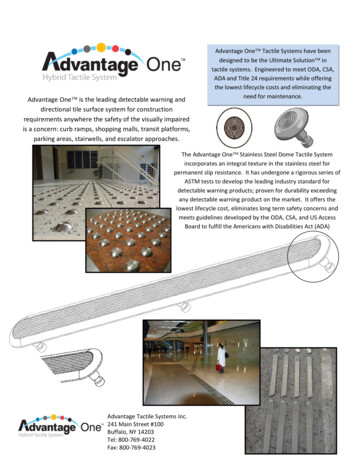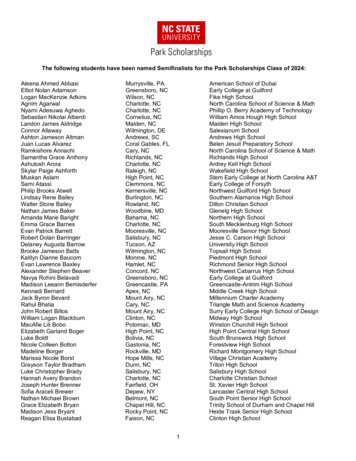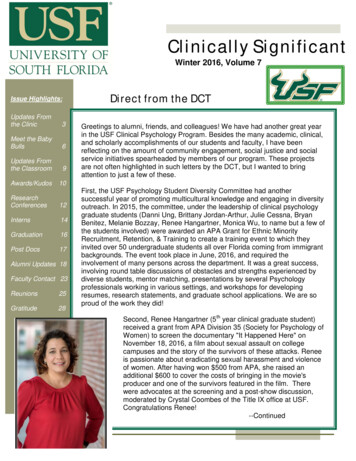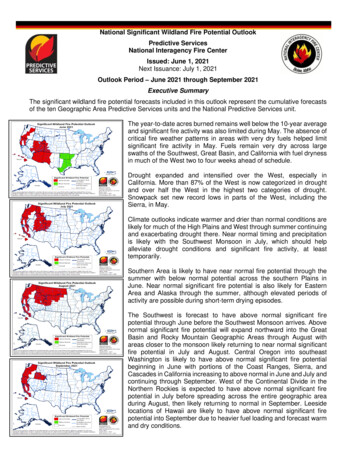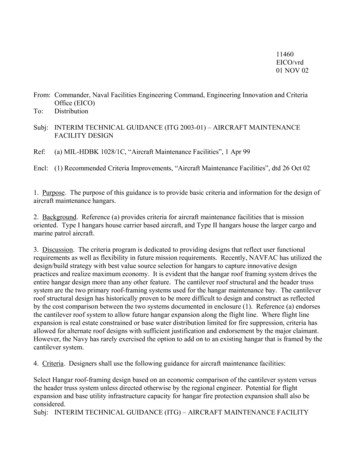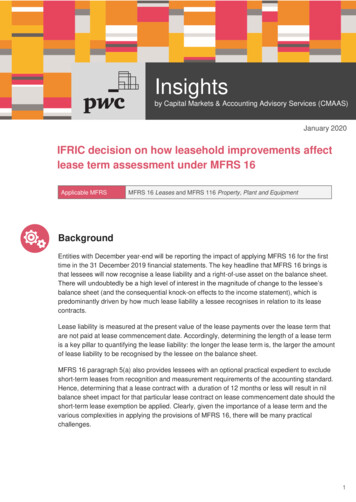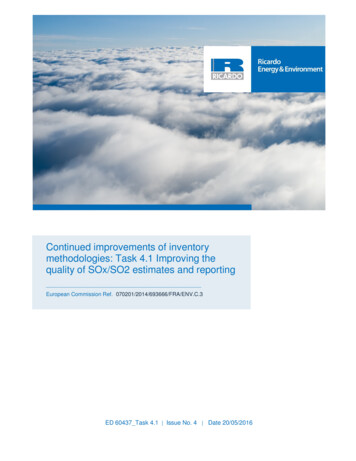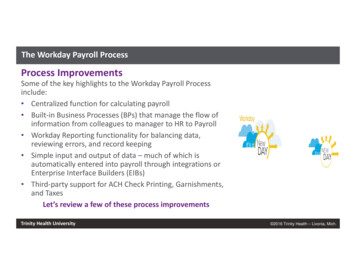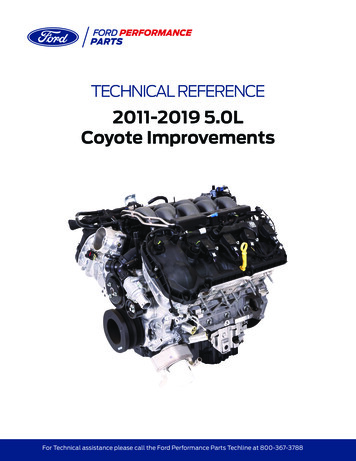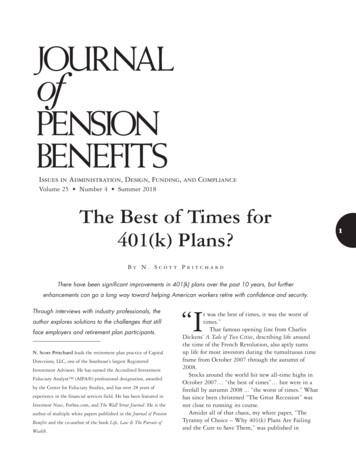
Transcription
Issues in Administration, Design, Funding, and ComplianceVolume 25 Number 4 Summer 2018The Best of Times for401(k) Plans?By N. Scott PritchardThere have been significant improvements in 401(k) plans over the past 10 years, but furtherenhancements can go a long way toward helping American workers retire with confidence and security.Through interviews with industry professionals, theauthor explores solutions to the challenges that stillface employers and retirement plan participants.N. Scott Pritchard leads the retirement plan practice of CapitalDirections, LLC, one of the Southeast’s largest RegisteredInvestment Advisors. He has earned the Accredited InvestmentFiduciary Analyst (AIFA ) professional designation, awardedby the Center for Fiduciary Studies, and has over 28 years ofexperience in the financial services field. He has been featured inInvestment News, Forbes.com, and The Wall Street Journal. He is theauthor of multiple white papers published in the Journal of PensionBenefits and the co-author of the book Life, Law & The Pursuit ofWealth.“It was the best of times, it was the worst oftimes.”That famous opening line from CharlesDickens’ A Tale of Two Cities, describing life aroundthe time of the French Revolution, also aptly sumsup life for most investors during the tumultuous timeframe from October 2007 through the autumn of2008.Stocks around the world hit new all-time highs inOctober 2007 “the best of times” but were in afreefall by autumn 2008 . “the worst of times.” Whathas since been christened “The Great Recession” wasnot close to running its course.Amidst all of that chaos, my white paper, “TheTyranny of Choice – Why 401(k) Plans Are Failingand the Cure to Save Them,” was published in1
2the Autumn 2008 edition of the Journal of PensionBenefits.The paper was my attempt to further the dialogueon how to improve the state of the 401(k) plan. Asthe title implies, the “cure” was in no longer forcingparticipants to make choices they have no interest inmaking.I advocated for a shift to professionally managedportfolios that removed the burden of the criticalasset allocation decision from participants who neverwanted that responsibility to begin with.I also advocated for a shift from conventionallymanaged (active) mutual funds to evidence-based (passive) funds.Interviews with almost 50 ERISA attorneys furtherconfirmed my belief that each of these steps would goa long way toward fixing 401(k) plans.Given the economic and market environment of thetime, I assumed the paper would be lost in the shuffle.But I was wrong. I apparently touched a nerve.Other retirement plan professionals, financialjournalists, and plan sponsors started contacting medirectly. The feedback was consistent: You’re ontosomething.I was even flattered to find that executives of oneof the country’s leading recordkeepers had used “TheTyranny of Choice” as a resource in reinventing theirparticipant experience.So now in 2018, with years of working on 401(k)solutions behind us, are we in “the best of times” for401(k)s? Have these plans been fully fixed, and arethey working optimally for employers and employees?To answer those questions, I spent the past fewmonths interviewing plan sponsors and a broad spectrum of 401(k) professionals (Employee RetirementIncome Security Act (ERISA) attorneys, plan auditors,and recordkeepers). We talked about where 401(k)plans have been, where they are now, and where we seethem heading in the future.The consensus was that we have made progress.More plans than ever now offer professionally managed portfolios. The use of evidence-based investing(aka passive or indexing) has increased significantlyand more plan sponsors are working with fiduciaryadvisors. (All-time highs in the stock market certainlyhave not hurt, either.)That said, the interviews revealed that two keychallenges remain unsolved:1. Most employers still do not understand theirfiduciary responsibilities and what it means toJournal of Pension Benefitsprudently run a retirement plan—leaving themsusceptible to serious financial risks.2. Participants still need more help maximizing theadvantages that 401(k) plans offer.Let’s explore each challenge in detail.Challenge #1: Helping EmployersBusiness owners are very knowledgeable about theirchosen area of expertise. Whether an attorney, physician, or other professional, you probably have yearsof experience that make you a true authority in yourfield.Unfortunately, it is unlikely that you have evertaken a class on Fiduciary Prudence 101. Yet sponsoring a retirement plan is a significant responsibility and exposes employers to significant personalliability.Although all plan sponsors are governed by thePrudent Expert Rule of ERISA, very few are familiar with the law’s key details. For example, the rulerequires that employers act “ with the care, skill,prudence, and diligence, under the circumstancesthen prevailing, that a prudent person acting in a likecapacity and familiar with such matters would use inthe conduct of an enterprise of a like character andwith like aims.”That is a pretty heavy burden for employers to bear.As David Johanson, an ERISA attorney with Hawkins,Parnell in Napa, California, said, “There continues to be amajor lack of understanding of the basics of fiduciary oversight among employers.”Ashley Smith of Dixon Hughes Goodman in Asheville,North Carolina, added that, “Running a retirement planis just not what most employers are in the business ofdoing.”But ignorance is not bliss for plan sponsors.Lawsuits against employers for a lack of properfiduciary oversight have become commonplace overthe past few years. These suits have spread evenbeyond corporate 401(k) plans into the world of403(b) plans sponsored by high-profile colleges anduniversities.The facts and circumstances vary from suit to suit,but the common thread is the lack of fiduciary oversight. In some cases, employers allowed their plans topay excessive fees. In others, employers continuallyoffered participants investment options that habituallyunderperformed.
The Best of Times for 401(k) Plans? Were these employers knowingly and maliciouslydodging their duties? No. They simply did not knowwhat they were supposed to be doing.But the bottom-line result has been that countlessplan participants have less in their accounts than theyshould, which translates directly into a lower standardof living for them in retirement. And in our litigioussociety, someone has to pay. Settlements in some caseshave exceeded 100 million.Those numbers are starting to get people’s attention. The plan sponsors paying those penalties do notwant to cut those checks again, so they are puttingbetter governance in place. But plaintiff’s attorneysare also taking note, and we are starting to see fiduciary lawsuits move down-market—including one suitagainst an employer with a 9 million plan.Can litigation drive progress? Certainly. Maybethese lawsuits will awaken employers to their fiduciaryresponsibilities. Maybe retirement plan professionalswill step up their game and be better advisors andconsultants in leading clients through a prudent, welldocumented process.Or, maybe there is an evolution similar to what wesaw for retirement plan participants with the PensionProtection Act of 2006 (PPA). Lawmakers realizedthat many employees were not taking advantage oftheir company’s retirement plan. Maybe it was ignorance or just inertia, but many people were not savingfor retirement.The PPA launched a wave of automatic features thathave had huge positive impacts on 401(k) participants.Automatic enrollment, auto-escalation, and QualifiedDefault Investment Alternatives (QDIA) have overcome ignorance and harnessed inertia to work for thebenefit of participants. Rather than having to activelyenroll, set a deferral rate, and manage investments, aparticipant who is too busy, or too disinterested, totake action can now be enrolled in the plan and set ona disciplined course of increasing contributions andinvested in a diversified portfolio. We are already seeing the positive effects of the PPA, and those benefitswill only increase with time.Could similar automatic features be implementedfor plan sponsors? While plan sponsors will alwaysretain some level of responsibility for fiduciary oversight, is there a way to put many of the required taskson auto-pilot?The closest things I have seen to fiduciary autopilot solutions are Multiple Employer Plans (MEP)and the hiring of a full-service ERISA 3(16) PlanAdministrator.3The MEP as Auto-PilotMEPs have been around for years and typically havebeen used by associations for their member organizations. Using this approach, there is one “Plan Sponsor”that runs the MEP, and the various employers who joinit are called “Adopting Employers.” Each AdoptingEmployer, in essence, delegates the day-to-day tasksof operating its retirement plan and may even savemoney through the shared economies of scale.MEPs began to build momentum a few years ago,and we even began to see Open MEPs, in which anyemployer could join regardless of a commonality withthe other participating employers (such as membership in an association).Unfortunately, increased regulatory scrutiny of theOpen MEP structure has cast uncertainty on whetherunrelated entities can legally partner in a retirementplan. This question remains largely unanswered, whichseems to be prohibiting any further growth in MEPs.Skip Schweiss, President of TD Ameritrade TrustCompany, says, “Lawmakers in Washington, DC see thebenefits of Open MEPs and we just need some clear direction from them on how MEPs can operate. So far, wehaven’t gotten that.”Outsourcing the Plan Administrator RoleSection 3(16) of ERISA describes the role of “PlanAdministrator” as the primary responsible party for aplan. Generally, the employer (aka the plan sponsor)forms a committee to oversee the plan, including thehiring of service providers. The committee typicallyhires a third-party administrator (TPA) to design theplan document and to ensure ongoing compliance. Arecordkeeper (often the same entity as the TPA, but notalways) is hired to maintain participant accounts, and aseparate custodian is used to hold the assets in trust.Employers can never fully divest themselves oftheir fiduciary duty to serve the best interests of participants in a company-sponsored retirement plan.But if they can document that it would be prudentto outsource their role as the plan administrator to aqualified third party capable of serving as an ERISA3(16) plan administrator, they can largely insulatethemselves from the day-to-day oversight of the plan.To see how such a decision could be shown to beprudent, consider some of the key daily duties that fallon a plan administrator: Approval of distributions to terminatedparticipants
4 Journal of Pension BenefitsApproval of loans and hardship withdrawalsDistribution of applicable plan noticesMonitoring the timeliness of contributionsHiring and firing of service providersMonitoring of fees to ensure reasonableness.For employers with experienced staff who can dedicate the time to these tasks, plan oversight can bemanageable.But for many employers, these tasks are assignedto a staff person who wears a lot of differenthats—and administration of the 401(k) plan istypically far down that staff person’s list of priorities.This often leads to inattention to the details and haphazard execution.For those employers, outsourcing the PlanAdministrator role may make sense. The tasks are thendone by an experienced professional who specializesin administering 401(k) plans. Meanwhile, the staffresources previously dedicated to overseeing the planlargely can be allocated to other, perhaps more profitable, tasks.A word of caution to the plan sponsor interested inhiring a 3(16) Plan Administrator: Not all 3(16)s arecreated equal.As employers’ interest in outsourcing plan administration has grown over the past few years, so has thenumber of companies offering 3(16) services. The challenge is that some providers offer only limited services.They will serve as a 3(16) only for a short menu oftasks, leaving much of the oversight on the employer.For employers seeking to fully outsource planadministration, my advice is to seek out a 3(16) PlanAdministrator that provides full delegation of all planadministration tasks. Yes, the employer still has tomonitor the 3(16) Plan Administrator, but the dayto-day role can be delegated with improved oversightand, in many cases, lower costs.Will broader adoption of MEPs or increased engagement of outsourced 3(16) Plan Administrators completely solve the general lack of proper fiduciaryoversight among plan sponsors? No. But, just likeauto-enrollment and auto-escalation have done for participants, both solutions can remove a burden from plansponsors that most of them do not want to begin with.In addition, employers are also increasingly hiringERISA 3(21) fiduciary advisors and 3(38) investmentmanagers, as advocated in “The Tyranny of Choice”10 years ago. These professionals do not perform anyof the 3(16) Plan Administrator duties, but they canreduce employers’ fiduciary liability by consultingwith plan sponsors on prudent best practices and providing one-on-one advice to participants. Additionally,3(38) investment managers actually take on fulldiscretion for investment selection and monitoring,removing that particular fiduciary liability from theplan sponsor.Challenge #2: Helping EmployeesEach 401(k) plan expert I interviewed acknowledged that we have come a long way in helping planparticipants save for a secure retirement. For example,more participants than ever before are using professionally managed portfolios. “Auto features” suchas automatic enrollment, automatic escalation, andQDIA have helped inertia to work for participantsrather than against them.But these professionals also acknowledged that participants still need more help in addressing three mainproblems:1 Professionally managed portfolio
The MEP as Auto-Pilot MEPs have been around for years and typically have been used by associations for their member organiza-tions. Using this approach, there is one “Plan Sponsor” that runs the MEP, and the various employers who join it are called “Adopting Employers.” Each Adopting Employer, in essence, delegates the day-to-day tasks
